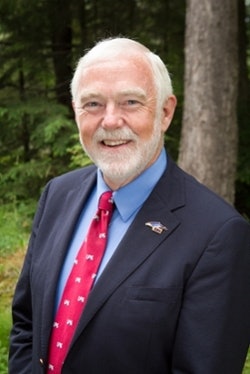After Dr. Richard A. Caulfield graduated from the University of California, Berkeley, in 1973, he was certain that his interests in anthropology and natural resource management would ultimately take him to Alaska.
However, Caulfield, who grew up in the San Francisco Bay area, had no idea that he would eventually emerge as one of Alaska’s most recognized leaders in higher education for his innovative approach to educating college students.
“I was young and interested in exploring Alaska,” says Caulfield, who took the helm as chancellor of the University of Alaska Southeast — a public four-year college that has nearly 4,000 students —in 2015.
 Chancellor Richard A. Caulfield
Chancellor Richard A. CaulfieldPrior to his appointment as chancellor, Caulfield served as the provost and executive dean at UAS, where he first received accolades for his advocacy work on behalf of Native Alaskan students.
“They are the original people of this place where we live,” he says matter-of-factly, adding that the university’s campus is located on ancestral territory. “I’m very mindful that our campus has an obligation to serve all people, but especially the indigenous people of this land.”
That cultural awareness for the plight of the Alaskan native peoples has always been important to Caulfield and was fueled in his early years. Shortly after graduating from Berkeley, he worked for five years in some of Alaska’s more remote and indigenous communities. It was in these settings that he learned from the Native American — or Native Alaskan — elders.
“Fresh from California, this gave me a perspective about Alaska that was totally different than what I had anticipated,” says Caulfield in an interview with Diverse. He recalls working with the elders of a local tribe on maps of the indigenous place names of local mountains, lakes and rivers.
“What it gave me was a clear sense that unlike the common notion that Alaska is America’s last frontier for wilderness, it became very clear that this has been the homeland of the Alaska native people for more than 10,000 years, so it gave me a real insight. I credit the elders of those communities who I remember by name today who were my first teachers, if you will, my first professors.”
Caulfield eventually decided to pursue a master’s degree in cross-cultural education from the University of Alaska Fairbanks and began teaching in the university’s rural development program, which was designed to provide students with the opportunity to earn a bachelor’s degree in rural development.
The program was specifically targeted toward younger indigenous communities —who were first-generation college students — and Caulfield was hired to teach in the field-base program.
“It was like teaching online education in the 1980s,” he recalls. “But it was largely by telephone. We didn’t have Blackboard and we didn’t have the internet.”
Because of its community development focus, Caulfield would travel to Alaska’s remote areas — where temperatures sometimes hovered at 50 degrees below zero — to tutor students enrolled in the program.
With the encouragement of a mentor, he decided to pursue a Ph.D. in developmental studies from the University of East Anglia in the United Kingdom.
“I wanted to get an international perspective on the rapid cultural change I had experienced in Alaska,” says Caulfield, who returned to the University of Alaska Fairbanks to teach in the rural development program and was eventually asked to take on an administrative position.
“I found that I really enjoyed [administrative work] and it gave me an opportunity to make a change at a more systemic level,” he says.
In 2010, he moved from the University of Alaska Fairbanks to UAS, located in Juneau — the state’s capital — to become an associate dean.
With Alaskan Native students comprising about 17 percent of the student population at UAS, Caulfield has been intentional about providing opportunities to attract and retain those students to the university.
The university is currently providing classes in indigenous languages, working with tribal organizations to provide instruction, in an effort to ensure that these languages, which are spoken by very few speakers, remain alive.
Caulfield has also been active in recruiting a diverse faculty.
“It’s been important for me to grow our faculty members from indigenous communities,” he says, adding that the university has given some of these newer faculty members release time from teaching so that they can pursue a Ph.D.
“I think it’s important that Alaskan Native students have faculty that come from similar backgrounds culturally,” Caulfield says, adding that in the upcoming year, he plans to expand partnerships with tribal organizations and support the Northwest Coast arts — a style of art created by artists from Native American tribes of the Northwest Coast of North America, from pre-European-contact times to the present.
“All of us from any background are enriched by having a diverse faculty,” he says.
This article appeared in the November 16, 2017 issue of Diverse magazine.





















